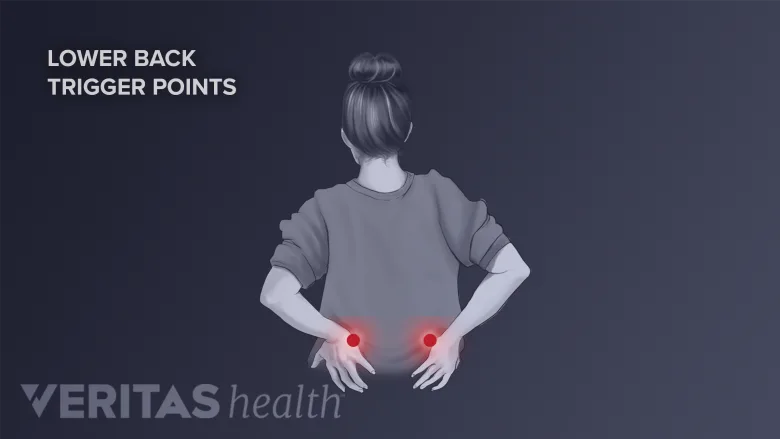The majority of people with isthmic spondylolisthesis are asymptomatic. Around 25% of people with the condition may experience pain around the affected spinal segment with a possibility of nerve involvement and radiating pain into the thigh and/or leg.1Bhalla A, Bono CM. Isthmic lumbar spondylolisthesis. Neurosurgery Clinics of North America. 2019;30(3):283-290. doi:10.1016/j.nec.2019.02.001
Isthmic spondylolisthesis typically occurs in childhood and affects the lower back, but the symptoms mostly start to manifest only by adolescence or in adulthood.2Ganju A. Isthmic spondylolisthesis. Neurosurgical Focus. 2002;13(1):1-6. doi:10.3171/foc.2002.13.1.2
In This Article:
Lumbar Isthmic Spondylolisthesis: Common Symptoms and Signs
The symptoms of isthmic spondylolisthesis vary depending on the severity of the condition.
The common symptoms and signs of isthmic spondylolisthesis in the lower back are described below:
Low back pain

Isthmic spondylolisthesis may cause a dull ache or a sharp, stabbing pain in the low back.
Low back pain is the most common symptom of isthmic spondylolisthesis. The pain is usually located in the lower back and may be described as a dull ache or a sharp, stabbing pain. The pain may be worse with activity and may improve with rest.3Burton MR, Dowling TJ, Mesfin FB. Isthmic Spondylolisthesis. [Updated 2022 Aug 8]. In: StatPearls [Internet]. Treasure Island (FL): StatPearls Publishing; 2023 Jan-. Available from: https://www.ncbi.nlm.nih.gov/books/NBK441846/
Sciatica
Sciatica, or lumbar radiculopathy, may occur in case of nerve root irritation or compression at the affected spinal segment. Sciatica symptoms include pain that radiates down one or both legs, which is often described as a shooting or burning sensation and may be accompanied by numbness or tingling.3Burton MR, Dowling TJ, Mesfin FB. Isthmic Spondylolisthesis. [Updated 2022 Aug 8]. In: StatPearls [Internet]. Treasure Island (FL): StatPearls Publishing; 2023 Jan-. Available from: https://www.ncbi.nlm.nih.gov/books/NBK441846/
Watch Sciatica Causes and Symptoms Video
Muscle weakness and areas of skin numbness

Spinal nerve compression can affect the areas of skin and groups of muscles supplied by the nerve
Isthmic spondylolisthesis can cause weakness in the muscles of the legs and buttocks. This can make it difficult to walk or stand for long periods of time.3Burton MR, Dowling TJ, Mesfin FB. Isthmic Spondylolisthesis. [Updated 2022 Aug 8]. In: StatPearls [Internet]. Treasure Island (FL): StatPearls Publishing; 2023 Jan-. Available from: https://www.ncbi.nlm.nih.gov/books/NBK441846/
The skin over the thigh, leg, and/or foot may feel numb or have diminished sensations in the areas supplied by the affected spinal nerve.3Burton MR, Dowling TJ, Mesfin FB. Isthmic Spondylolisthesis. [Updated 2022 Aug 8]. In: StatPearls [Internet]. Treasure Island (FL): StatPearls Publishing; 2023 Jan-. Available from: https://www.ncbi.nlm.nih.gov/books/NBK441846/
Leg pain while walking
Some people may experience neurogenic claudication, or pain in both legs while walking varying distances.3Burton MR, Dowling TJ, Mesfin FB. Isthmic Spondylolisthesis. [Updated 2022 Aug 8]. In: StatPearls [Internet]. Treasure Island (FL): StatPearls Publishing; 2023 Jan-. Available from: https://www.ncbi.nlm.nih.gov/books/NBK441846/
See Leg Pain and Numbness: What Might These Symptoms Mean?
Back stiffness

Postural changes from isthmic spondylolisthesis can cause increased lordosis and hamstring tightness.
Some people with isthmic spondylolisthesis may experience stiffness in the lower back. This can make it difficult to bend or twist the spine.3Burton MR, Dowling TJ, Mesfin FB. Isthmic Spondylolisthesis. [Updated 2022 Aug 8]. In: StatPearls [Internet]. Treasure Island (FL): StatPearls Publishing; 2023 Jan-. Available from: https://www.ncbi.nlm.nih.gov/books/NBK441846/
Additionally, the posture and muscles in the back and legs may be affected, including:
- Hamstring tightness. A tightness may be felt in the hamstring muscles along with a feeling of weakness or pain.4Li N, Scofield J, Mangham P, Cooper J, Sherman W, Kaye A. Spondylolisthesis. Orthop Rev (Pavia). 2022;14(4):36917. Published 2022 Jul 27. doi:10.52965/001c.36917
- Change in the curvature of the lower spine. The “C” shaped curve of the lower back may get exaggerated, causing lordosis (increased inward curving) or swayback.4Li N, Scofield J, Mangham P, Cooper J, Sherman W, Kaye A. Spondylolisthesis. Orthop Rev (Pavia). 2022;14(4):36917. Published 2022 Jul 27. doi:10.52965/001c.36917
- Stooped posture. Changes in the affected vertebral segment may cause balance and alignment issues, leading to a forward stooped posture.4Li N, Scofield J, Mangham P, Cooper J, Sherman W, Kaye A. Spondylolisthesis. Orthop Rev (Pavia). 2022;14(4):36917. Published 2022 Jul 27. doi:10.52965/001c.36917
Pain that worsens with activity and subsides with rest
Activities that involve hyperextension (bending backward) or rotation of the torso usually exacerbate the pain, and the pain is typically relieved with rest.5Pereira Duarte M, Camino Willhuber GO. Pars Interarticularis Injury. [Updated 2023 Feb 5]. In: StatPearls [Internet]. Treasure Island (FL): StatPearls Publishing; 2023 Jan-. Available from: https://www.ncbi.nlm.nih.gov/books/NBK545191/
Symptoms and Progression of Isthmic Spondylolisthesis in Children

A low back pain may be a symptom of isthmic spondylolisthesis in kids.
Symptoms of isthmic spondylolisthesis in children and teens can vary. Some kids may be asymptomatic, and the condition may incidentally be discovered during a routine medical examination or imaging. Others may experience localized lower back pain (axial back pain). This pain tends to worsen as the level of activity intensifies.6Mansfield JT, Wroten M. Pars Interarticularis Defect. [Updated 2022 Aug 21]. In: StatPearls [Internet]. Treasure Island (FL): StatPearls Publishing; 2023 Jan-. Available from: https://www.ncbi.nlm.nih.gov/books/NBK538292/
Some teens may complain of hamstring tightness, and a gait change (shortened stride length) may be seen around the pubertal age.7Stanitski CL. Spondylolysis and spondylolisthesis in athletes. Operative Techniques in Sports Medicine. 2006;14(3):141-146. doi:10.1053/j.otsm.2006.04.008
How Isthmic Spondylolisthesis Symptoms Affect Athletic Performance
Isthmic spondylolisthesis can have a significant impact on an athlete's performance. Chronic lower back pain can limit range of motion, flexibility, and overall athletic capabilities. Pain and discomfort may affect training consistency, resulting in decreased performance levels and potential setbacks in achieving athletic goals. Additionally, the fear of aggravating symptoms may impact an athlete's mental and emotional well-being.
The Relationship Between Isthmic Spondylolisthesis and Scoliosis

Isthmic spondylolisthesis and scoliosis may occur together in some individuals.
Low grade isthmic spondylolisthesis, typically at the L5-S1 spinal level, and scoliosis may occur together in some teenagers. The two conditions occurring in tandem usually does not influence the course or outcome of either condition, and each condition may be treated independent of the other, as needed.8Schlenzka D, Ylikoski M, Poussa M, Yrjönen T, Ristolainen L. Concomitant low-grade isthmic L5-spondylolisthesis does not affect the course of adolescent idiopathic scoliosis. Eur Spine J. 2019;28(12):3053-3065. doi:10.1007/s00586-019-06089-9
- 1 Bhalla A, Bono CM. Isthmic lumbar spondylolisthesis. Neurosurgery Clinics of North America. 2019;30(3):283-290. doi:10.1016/j.nec.2019.02.001
- 2 Ganju A. Isthmic spondylolisthesis. Neurosurgical Focus. 2002;13(1):1-6. doi:10.3171/foc.2002.13.1.2
- 3 Burton MR, Dowling TJ, Mesfin FB. Isthmic Spondylolisthesis. [Updated 2022 Aug 8]. In: StatPearls [Internet]. Treasure Island (FL): StatPearls Publishing; 2023 Jan-. Available from: https://www.ncbi.nlm.nih.gov/books/NBK441846/
- 4 Li N, Scofield J, Mangham P, Cooper J, Sherman W, Kaye A. Spondylolisthesis. Orthop Rev (Pavia). 2022;14(4):36917. Published 2022 Jul 27. doi:10.52965/001c.36917
- 5 Pereira Duarte M, Camino Willhuber GO. Pars Interarticularis Injury. [Updated 2023 Feb 5]. In: StatPearls [Internet]. Treasure Island (FL): StatPearls Publishing; 2023 Jan-. Available from: https://www.ncbi.nlm.nih.gov/books/NBK545191/
- 6 Mansfield JT, Wroten M. Pars Interarticularis Defect. [Updated 2022 Aug 21]. In: StatPearls [Internet]. Treasure Island (FL): StatPearls Publishing; 2023 Jan-. Available from: https://www.ncbi.nlm.nih.gov/books/NBK538292/
- 7 Stanitski CL. Spondylolysis and spondylolisthesis in athletes. Operative Techniques in Sports Medicine. 2006;14(3):141-146. doi:10.1053/j.otsm.2006.04.008
- 8 Schlenzka D, Ylikoski M, Poussa M, Yrjönen T, Ristolainen L. Concomitant low-grade isthmic L5-spondylolisthesis does not affect the course of adolescent idiopathic scoliosis. Eur Spine J. 2019;28(12):3053-3065. doi:10.1007/s00586-019-06089-9

